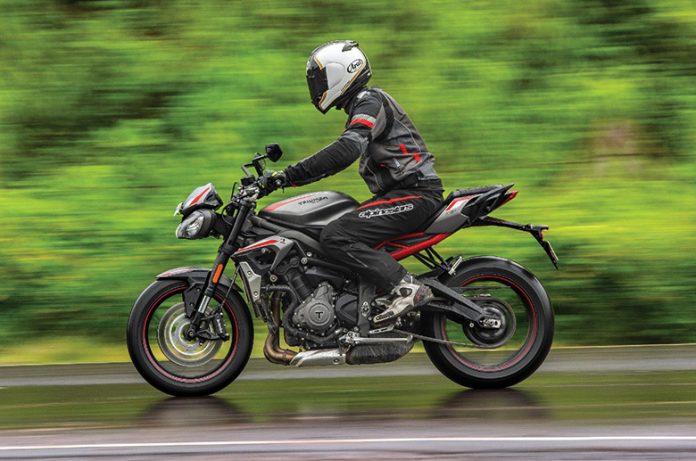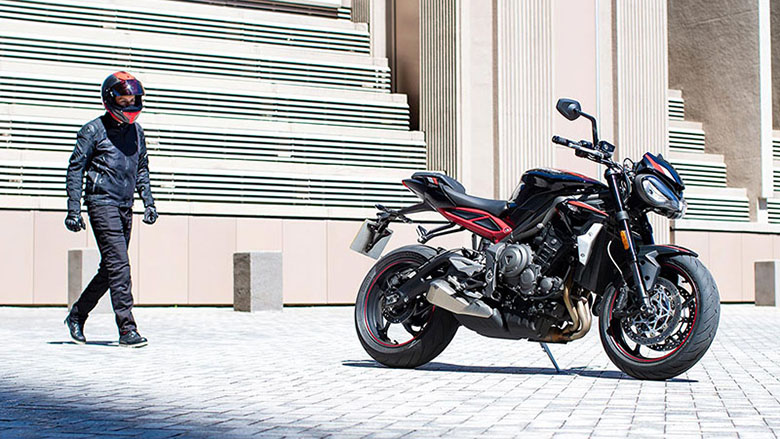Before the Model Year 2020, Triumph made several broad adjustments to the Street Triple R. Its racing credentials are enhanced with a new three-cylinder engine that is 11.3% more powerful than the one it replaces and a more aggressive nose-down design. The “Low” setting brings the seat down almost two inches, bringing it even closer to the surface.
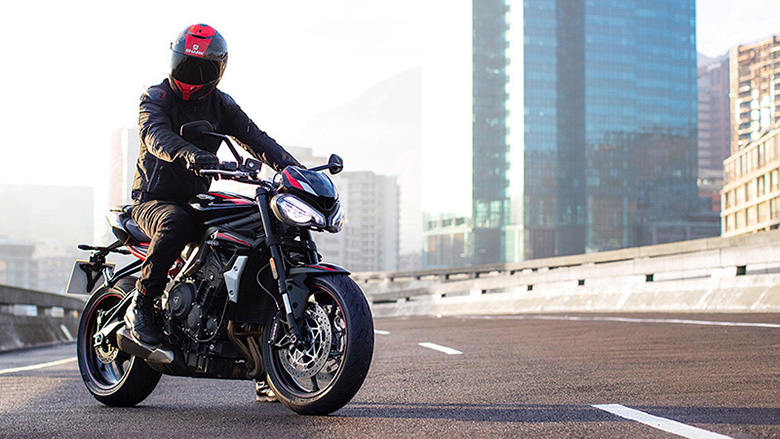
2022 Triumph Street Triple R Naked Motorcycle – Features and Specs
Design
The Street Triple R’s design stems from Triumph’s aim to make the Street Triple family the brand’s definitive naked streetfighters. A reduced front fender with foil-like uprights protects the total area of the inverted front forks from harm. Because of its small weight, there is less unsprung weight over the front axle, which improves ride quality and stability while keeping the front contact patch intact.
Its stealthy, ominous appearance befits its street-racing ability thanks to a thorough coating of blackout paint over all shiny surfaces. The twin LED headlights look like furious birds and let you see and be seen throughout the day with the daytime running lights (DRL) brows. Above the headlight housings is a short but broad fly screen designed to cover the LCD multifunction instrument display and its side screen. It can handle all the higher electrical responsibilities and the regular riding metrics. In addition to the blackout mirrors, the upgraded thumb controls include switch cubes and a five-way joystick set on a similarly black handlebar.
The 4.6-gallon petrol tank has a broad flange at the top that draws your legs into spacious knee pockets, facilitating human-machine contact. There is a sharp decrease in width between the fuel tank and the narrow waist at the rear. In addition, the tank and the upswept pillion pad are connected by a deep swale that holds a saddle with sculpted rails.
If you want a lower seat than the standard model’s 32.5-inch height from the floor, you may choose the “Low” version instead. Folding foot pegs that attach to the bike’s subframe are included for the passenger’s convenience, who can rest easy despite the absence of grab rails in the bike’s tail.
Above a tall and slim taillight, a thin mudguard holds the LED-powered rear blinkers, license plate holder, and tag light. As a whole, it seems that the maker has hit all of the marks necessary for a naked-street burner while yet maintaining a uniquely British flavor.
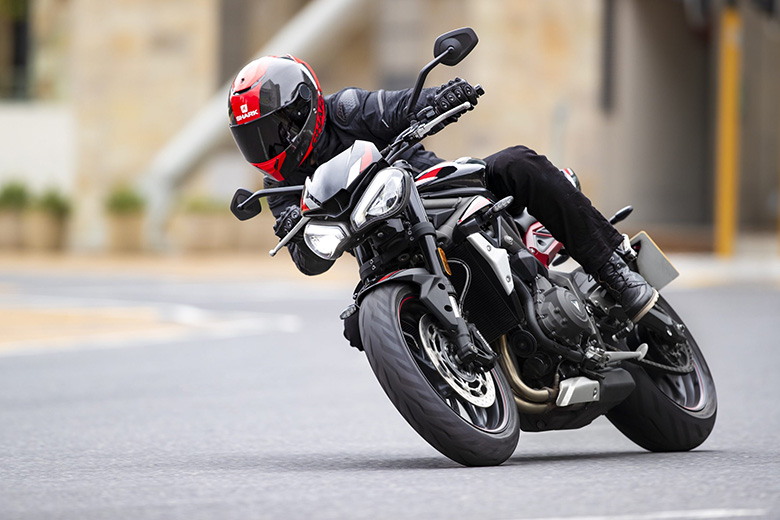
Chassis
The new Street Triple R’s twin-spar front frame, die-cast two-piece rear frame, and yoke-style swing arm are all lightweight aluminum. With a dry weight of under 370 pounds, it gets the job done with attractive colors.
The steering geometry of the front frame is 23.5 degrees of rake, including a dead-short 3.87 inches of the trail when the 17-inch front hoop is included, resulting in highly agile and almost twitchy handling.
The skinny 17-inch wheels have five spokes and are cast from aluminum; they’re shod with 120/70 and 180/55 size Pirelli Diablo Rosso Corso tires. They have a top speed “Z” rating that indicates how they work and can endure whatever punishment you and the Triple can dish out.
Both the front and rear suspensions have more than adequate travel for roads with polite traffic, with the front suspension being supported by inverted 41 mm Showa forks with 4.52 inches of travel and the whole trio of adjustments. The front brakes are also relatively robust, using a pair of 310 mm discs and four-bore Brembo radial Monobloc calipers to slow the vehicle. Back there, a 220 mm disc and single-pot binder take care of business, while the regular ABS keeps you from locking them up.
Drivetrain
The Street Triple R’s three-banger engine, a nod to the bike’s heritage and the legendary “Daytona” motor, is a significant upgrade over its forebear. The diameter is 77.99 mm, and the stroke is 53.38 mm for a total of 765 cc with a compression ratio of 12.5:1. The highest octane fuel available at a petrol station must be used in this engine.
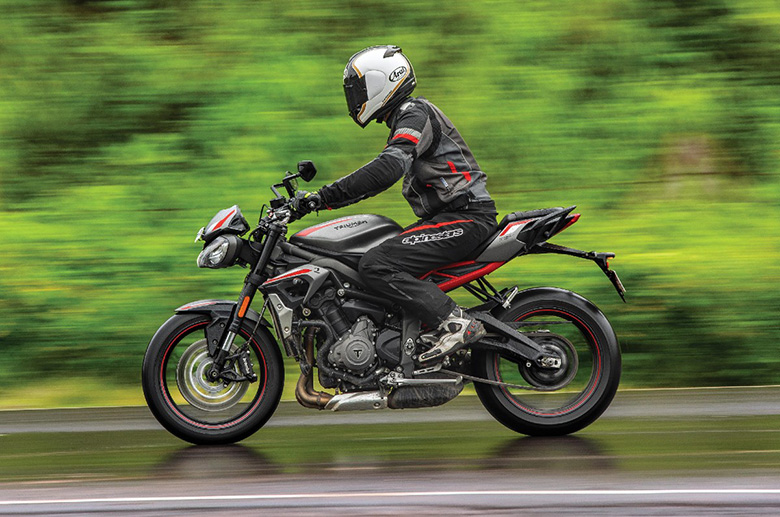
Using a ride-by-wire throttle control, the rider’s input is sent to an all-new electronic control unit (ECU). It includes three riding mode profiles that provide varying degrees of throttle response and traction control to help you keep it on the ground.
The triple engine prefers a snug fit due to its 116 horsepower at 12,000 rpm and 57 pound-feet torque at 9,400 rpm. By reducing back torque during hard downshifts and engine braking procedures, a slipper-type clutch connecting the engine to the gearbox improves the safety of the rear contact patch.
Standard on the “R” model is Triumph’s Shift assist, which facilitates rapid shifting between gears. A sturdy X-ring chain transfers power from the transmission to the back wheel via a six-speed gearbox. The maximum allowed speed is 144 miles per hour.
2022 Triumph Street Triple R Naked Motorcycle – Price
Whether you choose the standard or “Low” trim, you must pay $10,800. You may choose between two blackout treatments, one in Sapphire Black with red accents and the other in Matte Silver Ice with red details.
Triumph Street Triple R vs. Kawasaki Z900
The Z900’s bigger 948 cc four-cylinder engine is more potent than the Triumph’s, generating 125 shaft horsepower and 99 pound-feet torque. The Kawi benefits aesthetically from the manufacturer’s Sugomi concept, which tries to impart the qualities of a stalking animal on the hunt. In all honesty, my vote goes to Sugomi. The Trumpet’s odd sticky-outie light housing is why I dislike the vehicle. It seems too alien or insect-like for my taste.
Despite Triumph’s more substantial electronics package, the Kawi, which also carries the Z900, wins the beauty contest. The Z900’s suspension system suffers since it only has two Trumpet-introduced improvements. Honestly, I believe the most noticeable difference between these two is in their power figures, which makes the added cost of iABS, traction control, and power modes for Triumph much more excruciating.
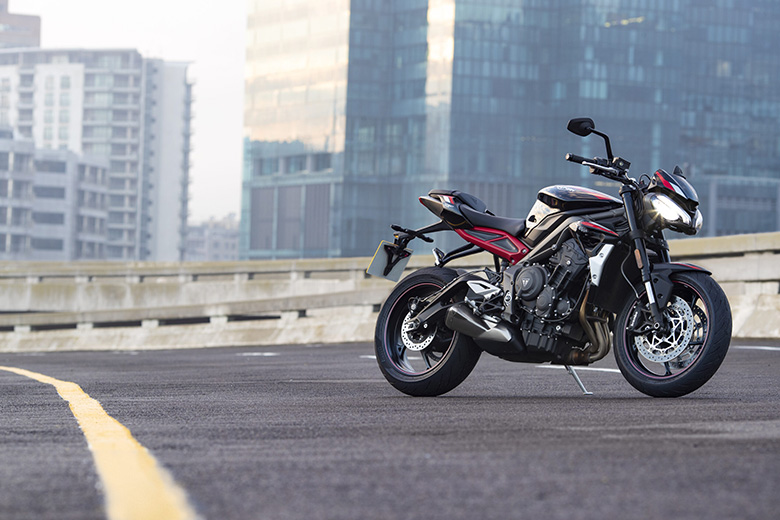
2022 Triumph Street Triple R Naked Motorcycle – Technical Specification
Engine & Drivetrain:
| Engine: | Liquid-cooled, 12-valve, 765cc, DOHC, inline 3-cylinder |
| Bore x Stroke: | 77.99mm x 53.38mm |
| Compression: | 12.5:1 |
| Max Power EC: | 116 hp at 12,000rpm |
| Max Torque EC: | 57 lb-ft at 9,400rpm |
| System: | Multi-point sequential electronic fuel injection featuring SAI. Electronic throttle control |
| Exhaust: | All-new stainless steel Three-into-One exhaust system low one-sided stainless steel silencer |
| Final Drive: | X-ring chain |
| Clutch: | Wet, multi-plate, slip-assisted |
| Gearbox: | 6-speed including Triumph Shift Assist |
Chassis:
| Frame: | Aluminum beam twin spar |
| Swingarm: | Twin-sided, cast aluminum alloy |
| Front Wheel: | All-new Cast aluminum alloy 5-spoke 17 x 3.5-inch |
| Rear Wheel: | All-new Cast aluminum alloy 5-spoke 17 x 5.5-inch |
| Front Tire: | 120/70 ZR17 |
| Rear Tire: | 180/55 ZR17 |
| Front Suspension: | All-new Showa 41mm of upside down separate function big piston forks (SF-BPF), Adjustable compression damping, rebound damping, and preload adjustment. |
| Rear Suspension: | Show a piggyback reservoir monoshock, Adjustable compression & rebound damping, and preload adjustment. |
| Rake: | 23.5-degree |
| Trail: | 3.87 inches (98.3mm) |
| Front Brakes: | Dual 310mm floating discs, Brembo M4.32 4-piston radial monobloc calipers, ABS |
| Rear Brakes: | Solo 220mm disc, Brembo single-piston caliper, ABS |
Dimensions and Capacities:
| Width Handlebars: | 30.5 in (775 mm) |
| Height Without Mirror: | 41.9 in (1,065 mm) |
| Seat Height: | 32.5 inches (825mm). Low seat version available: 30.7 inches (780mm) |
| Wheelbase: | 55.3 inches (1405mm) |
| Dry Weight: | 370 lbs (168 kg) |
| Fuel Capacity: | 4.6 gal (17.4 l) |
| Fuel Consumption: | 46 mpg (5.1 l/100km) |
Details:
| Instrument Display and Functions: | LCD multi-functional instrument pack including digital speedometer, a trip computer, analog tachometer, fuel gauge, gear position indicator, lap timer, programmable gear change lights, clock, and TPMS ready. 3 Riding Modes. |
| Color: | Sapphire Black, Matt Silver Ice |
| Price: | $10,800 |

